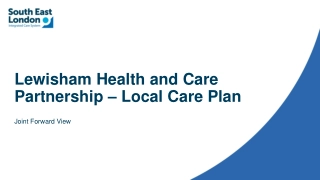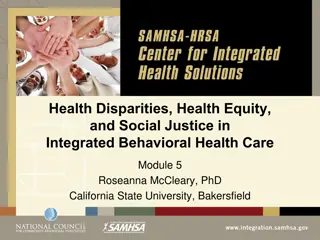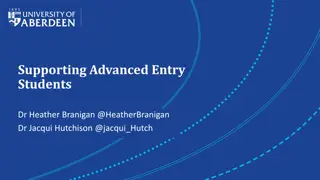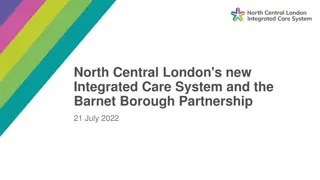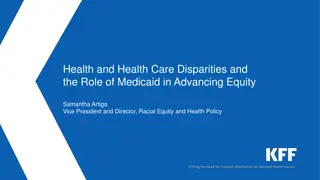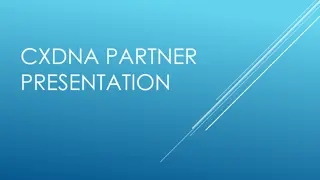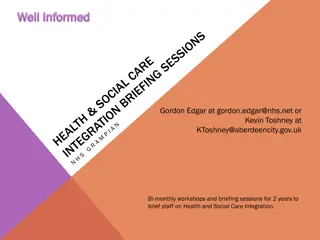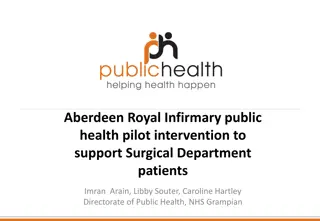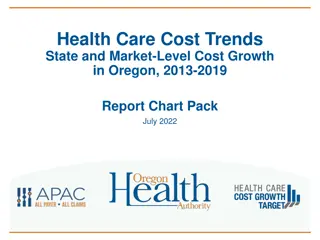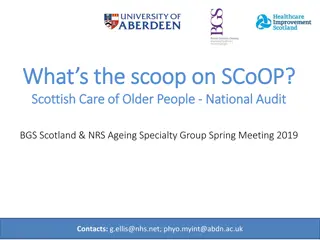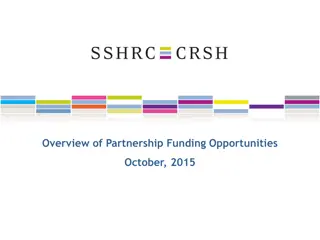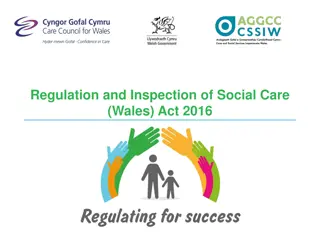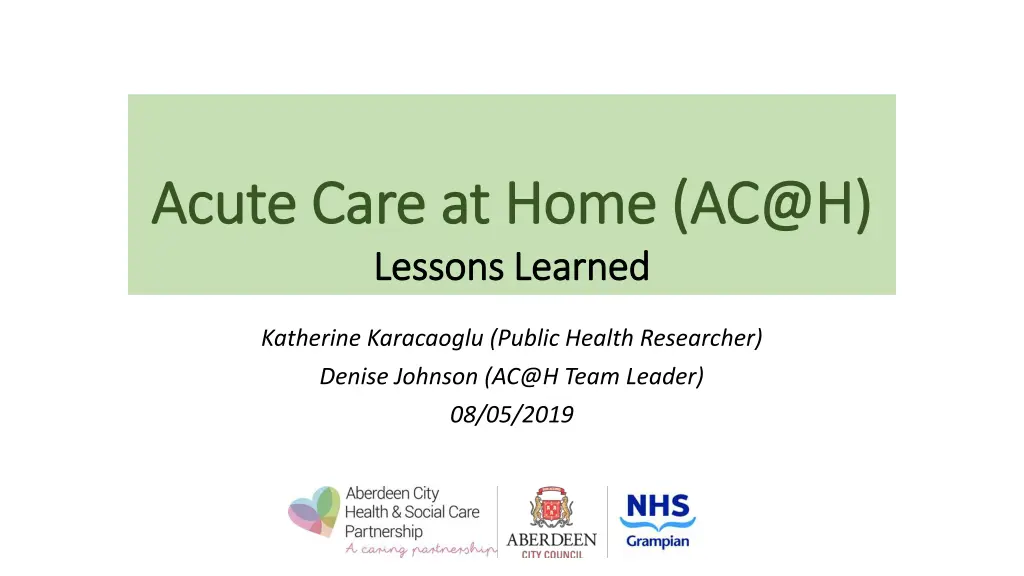
Lessons Learned from AC@H Service Implementation
Explore the AC@H service model, team composition, evaluation findings, and key highlights from the first 6 months of operation. Discover how AC@H aims to shift care from acute to community settings, providing safe and efficient care at home. Learn about the benefits of patient assessment at home and the impact on mortality rates and home living.
Download Presentation

Please find below an Image/Link to download the presentation.
The content on the website is provided AS IS for your information and personal use only. It may not be sold, licensed, or shared on other websites without obtaining consent from the author. If you encounter any issues during the download, it is possible that the publisher has removed the file from their server.
You are allowed to download the files provided on this website for personal or commercial use, subject to the condition that they are used lawfully. All files are the property of their respective owners.
The content on the website is provided AS IS for your information and personal use only. It may not be sold, licensed, or shared on other websites without obtaining consent from the author.
E N D
Presentation Transcript
Acute Care at Home (AC@H) Acute Care at Home (AC@H) Lessons Learned Lessons Learned Katherine Karacaoglu (Public Health Researcher) Denise Johnson (AC@H Team Leader) 08/05/2019
The AC@H Service The AC@H Service Previously big ticket item Based on Hospital at Home model A priority is to shift care from acute to community Hospital admissions carry risks
The AC@H Service Model The AC@H Service Model First 6 months Supported discharge pathway End of input Acute Care at Home care provision (1-7 days) Hospital Admission Patient Acutely unwell in the community Refer to AC@H when medically fit & appropriate Patient Discharged Hospital Admission Refer onwards e.g. to care management Patient unwell in the community (otherwise admitted to hospital) GP Refers to AC@H if appropriate Mid December onwards Alternative to admission pathway
The AC@H Service The AC@H Service First 6 months First 6 months Team composition: Advanced Nurse Practitioner, Physiotherapist, Occupational Therapist, Pharmacy Technician x 2 (covering 0.5 post), Health Care Support Workers x 5 Note: Consultant Geriatrician challenges In the first 6 months: 84 admissions to the service Majority referred from GAU (67%) Older adults with frailty requiring support following hospital discharge Referral reasons: mobility concerns or other functional assessments Care provided: reablement
AC@H Evaluation AC@H Evaluation This is a summary of the key findings from the first 6 months of service operation Full report available now
Highlights Highlights Key Findings Key Findings
1) AC@H appears no less safe than usual care 1) AC@H appears no less safe than usual care Patient Location at 3 months AC@H (N=82) GAU (N=1028) 6.8% lower mortality rates Deceased At home/community 9 (11%) 65 (79%) 183 (17.8%) 786 (76.5%) 2.5% more people living at home Mechanisms? Patient assessment at home You see a very small snapshot of how somebody actually functionally manages when you see them in an acute setting as oppose to when you see them at home Rapid access to care and resources Patients can get equipment faster through the OT rather than normally having to wait for the referral to go in. They get referred that morning, we go pick it up, the patient gets it that day
2 2) Patients reported high satisfaction with the service ) Patients reported high satisfaction with the service Mechanisms? Component Mean Score Satisfied 80% Critical timing of care provision Well-coordinated 78% they just feel relieved, more secure, comfortable realising that they have not just been put out of hospital and abandoned. Recommend? 82% Team Confidence 80% Continuity of Care (same as INCA) I was amazed at the amount of help I received. Each person knew exactly what they were going to do and did it all so cheerfully and willingly They all like continuity, they like the same person going in, which is not always the best thing for us but they look forward to you coming
3 3) ) Unpaid carers preferred their cared for person to be Unpaid carers preferred their cared for person to be treated at home and that this reduced stress levels treated at home and that this reduced stress levels Components Less stressed? Rather them at home? Recommend? Encouragement and support? Mean Score 88% 86% 96% 96% Mechanisms? Reassurance & time for a break Provided with support themselves? I could get my 3 hrs social visit and had no worries about my mum she was safe with him and I had a very relaxed time out shopping
4 4) ) H High staff igh staff satisfaction reported satisfaction reported - - particularly management management style style particularly The AC@H team were satisfied with their job - average score 73% Management satisfaction I think the senior team members are good team players they are, how they include you in everything Transparent There is no like, you know, hierarchy or things like that. Everyone is treated as an equal Non-Hierarchical any changes with the patient, we have a meeting and discuss the patient and we re asked for feedback once we ve seen the patient so I do feel like we are really included Included in decision making
5 5) ) Training is necessary to upskill, but restricts service Training is necessary to upskill, but restricts service provision if carried out during working hours in a small team provision if carried out during working hours in a small team On the assumption cannot recruit skilled APs.. Two options: 1) Prioritising upskill staff will limit service operation in the short to medium term 2) Prioritising limited upskilling of staff and consequently acuity of patients
6 6) ) Considering localised recruitment challenges, theoretically-sound models of care delivery should be sought out and adapted to deliver locally to account for these challenges. Currently: reablement support For service development? Other Health Professionals? Advanced Practitioners Require clinical oversight - supervisory model in both acute & community settings (Goldberg et al., 2016; Oliver, 2017) Could a GP with special interests take on this role?
Important learning Important learning 1) Key mechanisms: care provision at a vulnerable time for patients, continuity of care, rapid access to resources & the ability to carry out assessments in patients own home. 2) Unpaid carers preferred for their cared for person to be treated at home rather than hospital. 3) Having a more inclusive management style appears to lead to high staff satisfaction. 4) Prioritisation between service operation and staff upskilling should be identified both cannot progress simultaneously. 5) Considering localised recruitment challenges, theoretically-sound models of care delivery should be sought out and adapted to deliver locally to account for these challenges.


